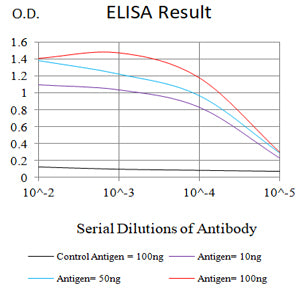
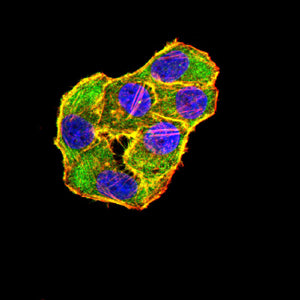
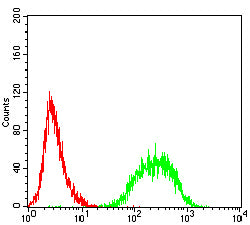
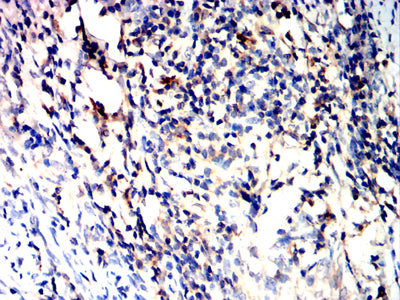
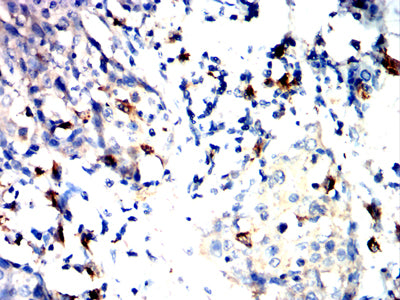
| WB | 咨询技术 | Human,Mouse,Rat |
| IF | 咨询技术 | Human,Mouse,Rat |
| IHC | 1/200 - 1/1000 | Human,Mouse,Rat |
| ICC | 1/200 - 1/1000 | Human,Mouse,Rat |
| FCM | 1/200 - 1/400 | Human,Mouse,Rat |
| Elisa | 1/10000 | Human,Mouse,Rat |
| Aliases | CD290 |
| Entrez GeneID | 81793 |
| clone | 1F8F2 |
| WB Predicted band size | 94.6kDa |
| Host/Isotype | Mouse IgG2b |
| Antibody Type | Primary antibody |
| Storage | Store at 4°C short term. Aliquot and store at -20°C long term. Avoid freeze/thaw cycles. |
| Species Reactivity | Human |
| Immunogen | Purified recombinant fragment of human TLR10 (AA: extra(20-219)) expressed in E. Coli. |
| Formulation | Purified antibody in PBS with 0.05% sodium azide |
+ +
以下是关于TLR10抗体的3篇代表性文献的简要概述:
---
1. **文献名称**:*TLR10 interacts with TLR2 and modulates TLR2-mediated responses in human macrophages*
**作者**:Oosting, M. et al.
**摘要**:该研究利用抗TLR10抗体阻断实验,揭示了TLR10与TLR2在人类巨噬细胞中的相互作用,证明TLR10可调节TLR2介导的炎症反应,提示其在感染性疾病中的潜在调控作用。
---
2. **文献名称**:*Characterization of a monoclonal antibody specific for human Toll-like receptor 10*
**作者**:Jiang, S. et al.
**摘要**:研究团队开发了一种针对人TLR10的单克隆抗体,验证了其在流式细胞术和免疫荧光中的特异性,并发现TLR10在B淋巴细胞表面高表达,为后续功能研究提供工具支持。
---
3. **文献名称**:*TLR10 is a novel anti-inflammatory innate immune receptor in human keratinocytes*
**作者**:Hess, E. et al.
**摘要**:通过抗TLR10抗体抑制实验,研究发现TLR10在角质形成细胞中抑制TLR2/1诱导的促炎细胞因子释放,表明其可能在皮肤免疫调节中发挥抗炎作用。
---
以上文献均聚焦于TLR10抗体的开发、功能验证及其在免疫调控机制研究中的应用。
Toll-like receptor 10 (TLR10), a member of the Toll-like receptor family, is a transmembrane pattern-recognition receptor involved in innate immune responses. Discovered in 2001. TLR10 is primarily expressed in immune cells like B cells, monocytes, and dendritic cells. Unlike other TLRs, its specific ligands and signaling mechanisms remain incompletely characterized, though it is believed to form heterodimers with TLR1 or TLR2 to recognize microbial components. Structurally, TLR10 contains leucine-rich repeat (LRR) domains for ligand interaction and a cytoplasmic Toll/interleukin-1 receptor (TIR) domain for downstream signaling.
TLR10 antibodies are critical tools for studying its expression, localization, and function. They enable detection of TLR10 in tissues and cells via techniques like flow cytometry, immunohistochemistry, and Western blotting. Research suggests TLR10 may play dual roles in immunity, exhibiting both pro-inflammatory and anti-inflammatory effects depending on context. Dysregulation of TLR10 has been linked to autoimmune diseases, cancers, and infectious diseases, making it a potential therapeutic target. However, challenges persist in clarifying its ligand specificity and signaling crosstalk. Current studies focus on developing monoclonal antibodies to modulate TLR10 activity, aiming to exploit its immunoregulatory potential in treating inflammation-related disorders or enhancing vaccine efficacy. Further research is needed to fully unravel its biological significance and translational applications.
×